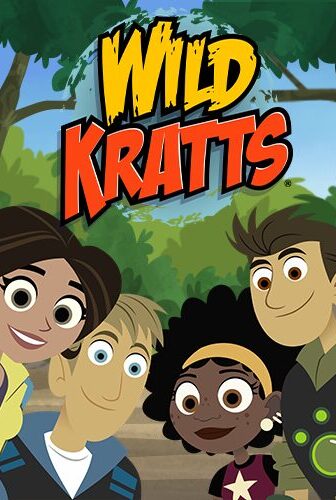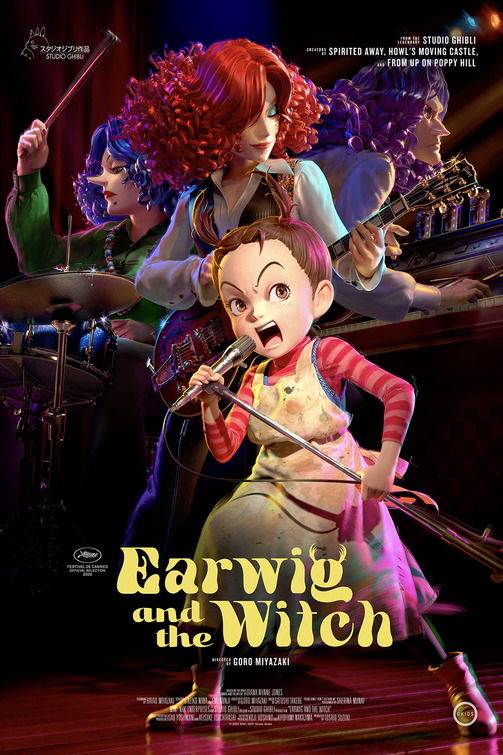“The Tale of the Willful Child”

| None | Light | Moderate | Heavy | |
|---|---|---|---|---|
| Language | ||||
| Violence | ||||
| Sex | ||||
| Nudity |
What You Need To Know:
EARWIG AND THE WITCH has some funny moments and colorful characters. However, the plot is too haphazard and unfocused and contains some scary transformations. Also, EARWIG AND THE WITCH has a strong, abhorrent occult worldview. It clearly promotes using witchcraft to protect oneself and manipulate other people. The movie sides with the young heroine’s desire to force and entice other people to do her will. Witchcraft is inherently self-centered, tyrannical and hostile to God. EARWIG AND THE WITCH is unacceptable.
Content:
Occult worldview wherein a young girl, left in an orphanage by her mother, likes to make (in a non-violent but persuasive and charismatic way) other people do things she wants and eventually learns to use magic to protect herself from, stop and turn the tables on a mean and threatening witch who uses her as her hard-working servant in a slavish way, but the girl manages to soften the demeanor of the witch and her scary husband, who is often angry and sullen and can transform himself into a scary version of himself when disturbed too much, plus there are two or three scenes with images of cross markers in a cemetery and orphanage next to cemetery is named after a saint
No foul language
Some light violence and scary images include woman uses a brush broom to push misbehaving young girl into her room (this knocks the girl into the bedpost at the foot of her bed), witch magically sends some worms through a magical hole in the ceiling of a girl’s room, and the worms just miss her, girl makes a hole in her wall to spy on the husband of the witch who has taken her into their cottage, girl uses voodoo magic to put two extra arms and hands on woman’s forehead and rear end, girl pushes worms through another hole into what she thinks is a bathroom, books fall on girl’s head, girl gets children at orphanage to dress as ghosts and play in a nearby cemetery, and a man walking his dog is startled, nearly falls down and runs away while the girls laugh, woman riding a speeding motorcycle dodges in and out of freeway traffic to evade a small yellow car (eventually, the woman uses magic to toss some worms into car’s front engine to stop the yellow car), and a tall man transforms himself into scary, threatening, much taller half-monster and half human creature
No sex
No nudity
No alcohol use
No smoking or drugs; and,
Heroine wants to control the people around her to bend to her will, woman uses young girl as her work slave and threatens her to feed her worms if she doesn’t obey to her satisfaction, spying, woman reneges on a promise she made, witch orders girl to grind up rat bones for a potion she’s selling, and another woman has to drop off her baby at an orphanage because she’s being chased by 12 witches.
More Detail:
The opens at night with a red-haired woman on a speeding motorcycle trying to evade a small yellow car following her on a four-lane freeway (two lanes going opposite ways). Some pink looking material comes out of her mouth and stalls the yellow car’s front engine.
Cut to the doorstep of a Christian orphanage. She pulls a baby girl from a front carryall and leaves the bay on the doorstep with a note. Before the puts the baby down, she tells the baby that she has named her Earwig, a thin pincher bug that inhabits gardens, flower beds and even homes.
When morning comes, the orphanage’s Matron and her assistant, Thelma, hear Earwig crying on the doorstep. They find the mother’s note, which says that 12 other witches are chasing her. She writes she will return one day to take back her daughter, Earwig, after she evades the witches, but it may take years. Thelma deduces that maybe the mother is a witch who left a coven. “Nonsense,” Matron replies. “There are no such things as witches.” When Matron introduces the baby to the other children, she changes the girl’s name to Erica Wig.
Several years later, Earwig is proud that she’s able to make everybody at the orphanage do what SHE wants. Her best friend is a blonde-haired boy nicknamed Custard. Earwig loves staying at the orphanage. So, whenever prospective families come to adopt one or more of the children, she makes faces to scare them off and make sure they don’t adopt her.
One day, however, an overweight older woman with purple hair, Bella Yaga, and her tall, sour-faced husband, Mandrake, pick Earwig to take home with them. At their little cottage, Mandrake keeps to himself. As soon as Bella gets Earwig alone, she warns her not to disturb Mandrake for any reason. Bella also tells Earwig right away that she’s a witch and that all she wants is for Earwig to help her clean, cook breakfast and prepare potions and things to sell to special clients. Earwig doesn’t mind any of this, but she demands that Bella show her how to use magic in exchange for her help. Bella seems to agree.
However, it soon becomes clear that Bella has no intention of teaching Earwig how to do magic. It also becomes clear that Bella just wants to work Earwig like a dog. In addition, Bella threatens to make Earwig eat worms if she doesn’t do Bella’s bidding.
Earwig’s situation becomes unbearable, of course. Especially since Bella has magically locked all the windows and doors that might let Earwig run away. One day, however, Earwig discovers that Bella’s familiar spirit, a small black cat named Thomas, can talk. Thomas tells Earwig he knows a way to turn the tables on Bella. He says he knows a spell in Bella’s spellbook that will do just that. Having a black cat by her side will help ensure the effectiveness of the spell, he adds, if only Thomas can remember all the words of the incantation.
Can Earwig turn the tables on Bella, without disturbing Mandrake, who happens to be an even more powerful witch than Bella? In fact, Mandrake not only can transform himself into a tall half man and half monster, he also has a bunch of little winged demons to fetch things for him, including food for dinner. Also, will Earwig ever get to see Custard again and will her mother ever return?
The story in EARWIG AND THE WITCH has a comical tone throughout it. That said, there are some scary things in it, such as Mandrake’s anger at being disturbed and his transformations. Eventually, though, Earwig’s ultimate goal is to bend Bella and Mandrake to her will, just as she bent everyone at the orphanage to her will. If she has to use magic to do it, so be it. The movie hints, however, that Earwig has inherent magical powers that enable her to get people to do what she wants. Of course, this is true in the real world actually. Some people just seem to have a knack, or a gift from God, to lead other people, or to convince other people to do things. Witchcraft or sorcery has nothing to do with this.
Be that as it may, the plot in EARWIG AND THE WITCH meanders a bit. For example, the plot problem is partly resolved haphazardly, where things just work out for the little heroine, in a seemingly accidental fashion. At least, that was MOVIEGUIDE®’s impression. Reportedly, an unfocused plot has been the biggest flaw noted in the work of popular British fantasy writer Diana Wynne Jones, who wrote the short novel on which this animated movie is based. EARWIG AND THE WITCH is directed by Goro Miyazaki, the son of famed Japanese animator Hayao Miyazaki, who directed HOWL’S MOVING CASTLE, another Studio Ghibli movie based on a novel by Jones.
Sadly, Jones’ fantasy novels often feature children or teenagers who at some point in the story use magic or witchcraft to solve personal problems, overcome evil or make their world a better place in some way. Born in 1934 and passing in 2011, Jones took classes at Oxford, where she attended lectures by Christian fantasy novelists J.R.R. Tolkien and C.S. Lewis. However, although her grandfather was a popular preacher in Wales and a talented public speaker, she reveals in her autobiography that she grew up in an unhappy home with neglectful, angry, secularized parents and decided as a child that she should be an atheist. Of course, it didn’t help that, when she was five, she and her younger sister were sent from England during World War II to live with her grandfather and his wife in Wales, next door to his church, where he gave his sermons in Welsh. Thus, as Jones says in her autobiography, she didn’t understand a word of what her grandfather preached from the pulpit, nor the Christian faith of the Welsh people around her. Reportedly, Jones’ novels and stories influenced the author of the Harry Potter books and the novelist behind the AMERICAN GODS series on the Starz Cable Channel. AMERICAN GODS is set in an Anti-Christian, unbiblical, pagan, and somewhat leftist, politically correct world where magic and supernatural powers are real, and the “Old Gods” (including a weird depiction of the Norse god Odin and several somewhat heretical depictions of Jesus) fear irrelevance in the face of the growing power of the “New Gods,” who include Tech Boy and Media.
Given the background and cultural influence of Diana Wynne Jones, the occult worldview in EARWIG AND THE WITCH clearly promotes using witchcraft and spells to protect oneself and manipulate other people. The first spell the young heroine performs is a spell of protection against the mean witch who turns the heroine into her servant. The second spell the heroine performs is a somewhat mean, but perhaps justified, trick on the mean witch, to teach her a lesson. A twist in the plot, however, results in the heroine finally getting her way. Also, [SPOILERS FOLLOW] Mandrake turns out to have a good side to him in the end, and he finally intervenes to force Bella to be kinder to Earwig and even to start teaching her how to use magic and witchcraft. The movie’s ending also strongly suggests, however, that Earwig’s inherent charm and magical way with people eventually has a positive effect on both Mandrake and Bella, softening their hearts.
Ultimately, though, the ending to EARWIG AND THE WITCH shows that magic and witchcraft will make good things happen for you. This is disturbing and abhorrent. Perhaps even more disturbing and abhorrent is that the movie sides with the young heroine’s desire to force and entice other people to do her will. In reality, witchcraft is inherently self-centered and tyrannical, as well as hostile and disobedient to God, Thus, the story, themes and messages in EARWIG AND THE WITCH tend to confirm this truth. Finally, while the little demons that fetch dinner for Mandrake behave in a comical fashion and are drawn to look comical, they still conjure visions of Hell, as do Mandrake’s scary transformations.


 - Content:
- Content: 
